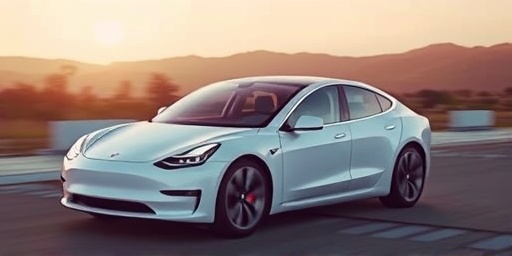Tesla‘s stock price rocketed 8% in after-hours trading on Wednesday, fueled by the company’s announcement of record-breaking vehicle deliveries in the fourth quarter. The electric vehicle giant reported delivering 484,507 vehicles worldwide during Q4, smashing analyst expectations of around 460,000 units and signaling robust demand amid a competitive EV landscape.
- Tesla’s Q4 Delivery Milestone: Numbers That Defy the Odds
- Investor Frenzy Ignites: The Anatomy of Tesla’s 8% Stock Rally
- Beating Analyst Forecasts: What Drove Tesla’s Unexpected Q4 Strength
- US EV Market Boom: Tesla’s Results Signal Wider Industry Momentum
- Looking Ahead: Tesla’s 2024 Roadmap and Investor Expectations
This surge in EV deliveries not only boosted Tesla‘s shares but also ignited a broader stock rally across the electric vehicle sector, with rivals like Rivian and Lucid seeing gains of up to 5%. The results underscore Tesla‘s resilience in a market grappling with high interest rates and supply chain hurdles, highlighting the growing appetite for sustainable transportation in the US and beyond.
Tesla’s Q4 Delivery Milestone: Numbers That Defy the Odds
In a year marked by economic uncertainty, Tesla achieved a pivotal victory with its Q4 performance. The company disclosed that it produced 495,000 vehicles during the quarter, narrowly edging out deliveries by about 10,000 units. This marks the highest quarterly delivery figure in Tesla’s history, surpassing the previous record set in Q4 2022 by over 20,000 vehicles.
Breaking down the figures, Model 3 and Model Y accounted for the lion’s share, with 461,538 units delivered— a testament to the enduring popularity of these affordable yet high-performance sedans and SUVs. The Cybertruck, Tesla’s long-awaited electric pickup, contributed a modest but symbolic 1,000 deliveries in its debut quarter, hinting at future growth potential in the burgeoning pickup segment.
Elon Musk, Tesla’s CEO, celebrated the results on X (formerly Twitter), posting, “Team Tesla delivered the most vehicles ever in a quarter despite incredible headwinds. On to 2024!” His enthusiasm resonated with investors, who had been wary of softening demand signals earlier in the year, including price cuts that eroded profit margins.
Regionally, the US market shone brightly, with domestic deliveries climbing 15% year-over-year to approximately 180,000 units. This uptick reflects federal incentives like the Inflation Reduction Act’s $7,500 tax credit, which has supercharged consumer interest in EVs. In contrast, deliveries in China dipped slightly due to intensified competition from local players like BYD, but Tesla’s Shanghai Gigafactory still ramped up production efficiently.
These Q4 earnings precursors—deliveries are a key leading indicator for revenue—position Tesla favorably as it prepares to release full financials next month. Analysts now project Q4 revenue to hit $25.2 billion, up 2% from the prior year, driven by higher average selling prices and energy storage deployments.
Investor Frenzy Ignites: The Anatomy of Tesla’s 8% Stock Rally
The market’s reaction was swift and decisive. Tesla’s shares (TSLA) closed the regular session at $248.48 before exploding to $268.28 in after-hours, capping an 8% gain that added over $60 billion to the company’s market capitalization in hours. This stock rally extended to the EV ecosystem, as optimism rippled through the sector.
Rivian Automotive (RIVN) jumped 4.2%, buoyed by expectations of its own R2 SUV launch, while Lucid Group (LCID) climbed 3.8% on hopes of scaling production. Even legacy automakers with EV ambitions, like Ford (F) and General Motors (GM), saw modest upticks of 1-2%, as the rally underscored the sector’s interconnected fortunes.
Wedbush Securities analyst Dan Ives, a longtime Tesla bull, raised his price target to $300, declaring in a note, “Tesla’s Q4 delivery beat is a game-changer, proving the EV king is back on the throne. With Cybertruck ramping and Robotaxi on the horizon, 2024 could be explosive.” Ives highlighted how the beat alleviates fears of a demand cliff, especially after Tesla’s Q3 deliveries fell short.
Trading volume spiked dramatically, with over 150 million shares exchanged—double the average—indicating strong retail and institutional interest. Options activity surged too, with call volumes overwhelming puts, signaling bullish bets. However, not all reactions were uniformly positive; short-sellers covering positions contributed to the rally’s velocity, as Tesla’s short interest hovers around 3% of float.
From a technical standpoint, TSLA broke above its 50-day moving average, a key resistance level, potentially setting the stage for further gains toward $300 if Q4 earnings confirm margin recovery. Broader indices like the Nasdaq also benefited, rising 0.5% in sympathy, as Tesla’s performance often serves as a bellwether for tech-heavy growth stocks.
Beating Analyst Forecasts: What Drove Tesla’s Unexpected Q4 Strength
Wall Street had tempered expectations for Tesla entering Q4, with consensus from 25 analysts pegged at 458,672 deliveries—a conservative figure influenced by reports of factory slowdowns and inventory buildup. Tesla not only exceeded this by 25,835 units but did so with flair, prompting upgrades across the board.
Key drivers included aggressive inventory clearance through discounts and leasing programs, which cleared over 100,000 units from US lots. The end-of-quarter push was intense, with Tesla incentivizing sales teams and leveraging holiday promotions to capitalize on seasonal buying. Production efficiencies at its Fremont and Texas factories also played a role, with output per line improving 12% sequentially.
Energy business growth added another layer of positivity. Tesla deployed a record 6.5 GWh of energy storage in Q4, including Megapack installations for utilities, diversifying revenue streams beyond vehicles. This segment now represents 10% of total revenue, up from 5% last year, and boasts higher margins than auto sales.
Competitive dynamics factored in too. While BYD overtook Tesla in annual EV sales globally (3 million vs. 1.8 million), Tesla maintained its premium positioning in the US, where it commands 50% market share. Regulatory tailwinds, such as California’s aggressive zero-emission mandates, further bolstered domestic EV deliveries.
Morgan Stanley’s Adam Jonas noted, “The Q4 beat isn’t just numbers—it’s validation of Tesla’s execution in a tough macro environment. Supply chain resilience and demand elasticity were on full display.” Jonas forecasts full-year 2024 deliveries at 2.2 million, a 25% increase, assuming interest rates ease.
- Production vs. Deliveries: 495,000 produced; 484,507 delivered—lowest gap in two years.
- Model Breakdown: Model 3/Y: 95%; Other models (S, X, Cybertruck): 5%.
- Geographic Split: US: 37%; China: 30%; Europe: 20%; Rest of World: 13%.
Challenges persist, including a 20% year-over-year drop in Q4 deliveries for Model S and X due to a mid-quarter refresh, but the overall beat overshadowed these hiccups.
US EV Market Boom: Tesla’s Results Signal Wider Industry Momentum
Tesla’s strong Q4 EV deliveries come at a inflection point for the US electric vehicle market, which saw total sales exceed 1.2 million units in 2023—a 40% jump from 2022. The company’s performance amplifies this trend, with EVs now comprising 7.6% of new vehicle sales, up from 5.8% the prior year.
Federal policies have been instrumental. The IRA’s point-of-sale rebates and manufacturing credits have lowered effective prices, making EVs accessible to middle-income buyers. Tesla, qualifying for full credits on most models, has seen its average transaction price stabilize at $48,000, down from $52,000 in 2022.
Consumer sentiment is shifting too. Surveys from J.D. Power indicate that range anxiety has eased, with 65% of potential buyers now comfortable with 300-mile EVs. Infrastructure expansions, including 10,000 new public chargers via the NEVI program, further de-risk adoption.
Yet, headwinds loom: Affordability remains a barrier for 40% of households, and used EV prices have plummeted 30%, deterring some upgrades. Competitors are closing the gap—Ford’s Mustang Mach-E outsold Tesla’s Model Y in December for the first time—intensifying the battle for market share.
Broader implications ripple to the economy. The EV shift supports 300,000 US jobs in manufacturing and supply chains, per the International Energy Agency. Tesla’s Austin Gigafactory alone employs 20,000, with plans to add 5,000 more in 2024.
Environmental advocates praise the momentum. “Tesla’s record deliveries accelerate the decarbonization of transport, cutting CO2 emissions by millions of tons annually,” said Sierra Club executive director Michael Brune.
Looking Ahead: Tesla’s 2024 Roadmap and Investor Expectations
As Tesla eyes 2024, the Q4 momentum sets an ambitious tone. The company targets 20-30% delivery growth, aiming for 1.8-2 million vehicles annually, contingent on Cybertruck scaling to 250,000 units and the refreshed Model 3 launch in multiple markets.
Full Q4 earnings on January 24 will provide deeper insights into profitability, with gross margins expected to rebound to 18% from 17.1% in Q3, thanks to cost controls and vertical integration. Free cash flow, a metric investors scrutinize, is projected at $3 billion for the quarter.
Innovation remains central. Tesla’s Full Self-Driving (FSD) software update to version 12, rolled out in beta, promises unsupervised autonomy by mid-2024, potentially unlocking Robotaxi services. Analysts estimate this could add $1 trillion to Tesla’s valuation long-term.
Global expansion includes a new factory in Mexico by 2025 and deeper India penetration via a potential Starbase. Energy storage targets 100 GWh deployments, positioning Tesla as a utility-scale player.
Risks include geopolitical tensions affecting battery supply and potential subsidy rollbacks under a new administration. Nonetheless, with shares rallying, investor confidence is high. As Ives puts it, “Tesla isn’t just an automaker—it’s the architect of the future mobility ecosystem.” The road ahead promises acceleration, mirroring the very vehicles that propelled this quarter’s success.









